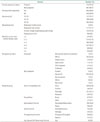Abstract
Objectives
The accumulated evidence shows that adult disease may have origins during the fetal period and maternal environmental exposure may affect fetus and infant health. To assess the environmental health of fetus and infants and examine women's concerns about environmental health, we designed and conducted an environmental health survey in reproductive-aged women in 2011.
Methods
A stratified multi-stage design was adopted for our survey, and 1,000 reproductive-aged women aged 25 to 39 years participated. The participants were asked to complete an electronic questionnaire using the computer-assisted web interviewing method. All the participants were married woman, and 80% had experienced pregnancy before completing the survey.
Results
In the study, 86.3% of the participants responded that they are worried about the environmental problems that may affect the fetus and infant. The participants responded that they were most worried about global warming and climate change (36.2%), electromagnetic waves (31.4%), and endocrine disrupting chemicals (25.1%). Moreover, participants responded that environmental problem can cause children's allergic disease, such as atopic dermatitis, metabolic syndrome and growth development.
Figures and Tables
Table 4
Prioritizing environmental risk assessment to fetus and infant health by individual risk factor*

Table 5
Assessment of the risk of environmental pollution having various adverse effects on fetal development*

Acknowledgments
This study was supported by MOCEH (Mothers and Children's Environmental Health) project of the Ministry of Environment, Republic of Korea.
References
1. Miller GE, Chen E, Parker KJ. Psychological stress in childhood and susceptibility to the chronic diseases of aging: moving toward a model of behavioral and biological mechanisms. Psychol Bull. 2011; 137:959–997.

2. Trasande L, Landrigan PJ. The National Children's Study: a critical national investment. Environ Health Perspect. 2004; 112:A789–A790.

3. Kawamoto T, Nitta H, Murata K, Toda E, Tsukamoto N, Hasegawa M, et al. Rationale and study design of the Japan Environment and Children's Study (JECS). BMC Public Health. 2014; 14:25.

4. Maitre L, Villanueva CM, Lewis MR, Ibarluzea J, Santa-Marina L, Vrijheid M, et al. Maternal urinary metabolic signatures of fetal growth and associated clinical and environmental factors in the INMA study. BMC Med. 2016; 14:177.

5. Kim BM, Ha M, Park HS, Lee BE, Kim YJ, Hong YC, et al. The Mothers and Children's Environmental Health (MOCEH) study. Eur J Epidemiol. 2009; 24:573–583.

6. Brugge D, Leong A, Averbach AR, Cheung FM. An environmental health survey of residents in Boston Chinatown. J Immigr Health. 2000; 2:97–111.
7. Cohen A, Lopez A, Malloy N, Morello-Frosch R. Our environment, our health: a community-based participatory environmental health survey in Richmond, California. Health Educ Behav. 2012; 39:198–209.
8. Hahm MI, Kwon HJ, Lee HY, Park HG, Lee SG. Differences of experts and non-experts in perceiving environmental and technological risks. Korean J Environ Health Sci. 2009; 35:269–277.

9. Park CY, Chang EA, Shin DC, Lim YW, Choi WH. Related factors of environmental risk perception among general public and experts. Korean J Environ Toxicol. 2001; 16:85–95.
10. Ye S, Ha E, Chung H, Jeong K, Sung Y, Lee H, et al. Awareness and demand of environmental health service in premenopausal women. In : Symposium of the Korean Society of Environmental Health and Toxicology; 2013 May 21; Seoul, Korea. Seoul: Korean Society of Environmental Health and Toxicology;2014. p. 194.
11. Ha EH, Kim BN, Kim YJ, Kim EJ, Kim YH, Kim YN, et al. Environmental exposures and health effects in pregnant women and infants (I). Incheon: National Institute of Environmental Research;2011.
13. Demain JG. Climate change and the impact on respiratory and allergic disease: 2018. Curr Allergy Asthma Rep. 2018; 18:22.

14. Yang BY, Qian ZM, Li S, Fan S, Chen G, Syberg KM, et al. Longterm exposure to ambient air pollution (including PM(1)) and metabolic syndrome: the 33 Communities Chinese Health Study (33CCHS). Environ Res. 2018; 164:204–211.

15. Park J, Jung W, Kim E, Choi Y. Study on the relationship between PM10 concentration and deaths from asthma in Seoul, Korea. In : Proceedings of the Korean Environmental Sciences Society Conference; 2014 Nov 6–8; Daegu, Korea. Busan: Korean Environmental Sciences Society;2014. p. 80–85.
16. Kim SH, Yang HJ, Jang AS, Kim SH, Song WJ, Kim TB, et al. Effects of particulate matter in ambient air on the development and control of asthma. Allergy Asthma Respir Dis. 2015; 3:313–319.

17. Yang HJ, Kim SH, Jang AS, Kim SH, Song WJ, Kim TB, et al. Guideline for the prevention and management of particulate matter/yellow dust-induced adverse health effects on the patients with bronchial asthma. J Korean Med Assoc. 2015; 58:1034–1043.

18. Kyung SY, Kim YS, Kim WJ, Park MS, Song JW, Yum H, et al. Guideline for the prevention and management of particulate matter/Asian dust particle-induced adverse health effect on the patients with pulmonary diseases. J Korean Med Assoc. 2015; 58:1060–1069.

19. Kim Y, Lee H, Lee H, Jang Y. A study on the audience's perception and opinion formation by press report about the risk of particulate matter. In : Proceedings of the Korean Society for Journalism and Communication Studies Conference; 2015 May 15–16; Pohang, Korea. Seoul: Korean Society for Journalism and Communication Studies;2015. p. 20–21.
Supplementary Materials
Supplementary materials are available from: https://doi.org/10.12771/emj.2018.41.2.35.




 PDF
PDF ePub
ePub Citation
Citation Print
Print








 XML Download
XML Download